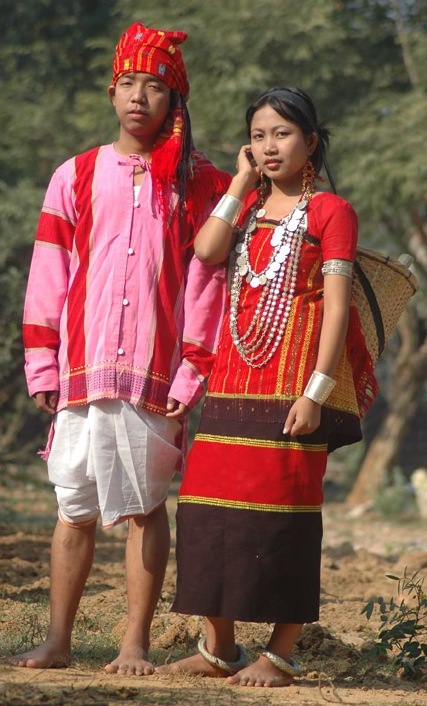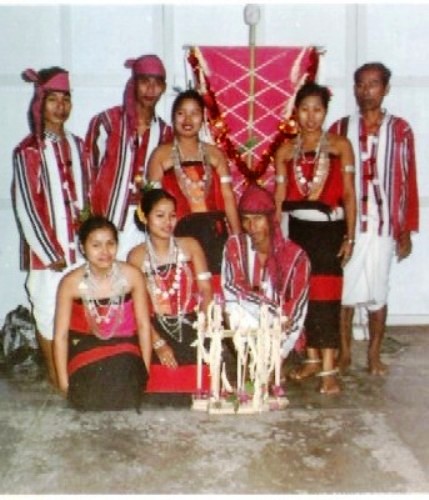The
Tripura were in practice Huk
cultivation in the past, that is jhum
cultivation like most of the Tripuri
people of Tripura. But ploughing
cultivation and agriculture in
conventional method are the practice of
the present day. The educated are
employed in the government job, doing
business, in politics and occupying the
ministerial post in the state.
Traditionally they are more or less
similar to the Tripur clan,
excepting certain deviation with regard
to the disposal of corpse were they
follow the Reang customs. The worship
and the festivals of Tripura's are in
close resemblance to those of other
clans of Tripuri people. They also
believe one supreme god Mutai kotor, the
creator of the world, who in course if
time has been identified as Subrai. They
believe that there exists an invisible
relationship between the deities and the
living creature. Besides Subrai, the
Tripura recognise a good number of nature
deities, spirits like other Tripuri
people.
Tripura couple with Goria Deity
•
Mutai kotor :
Supreme supernatural creator of the
world, Sibrai that is the Lord Siva.
•
Mutai kotorma : The
Consort of Mutai kotor, that is Goddess
Parvati or Durga.
•
Bikhitra : The god
of sky, that is god Indra.
•
Sangrongma : The god
of earth, that is the Mother Goddess.
•
Mailuma : The
goddess of rice, that is Laxmi.
•
Twima : The goddess
of water, that is Goddess Ganga.
•
Akhatra : The god of
sea.
•
Khuluma : The
goddess of cotton equalized with Goddess
Saraswati.
Other than nature Gods
•
Goria : the god of
war, fertility, and wealth.
•
Kalia : the spirit
of ancestor.
•
Noksumutai : the
spirit of the Family.
•
Haichukma : the
spirit of hill and mountain, that is
Parvati.
•
Sirijumdu : the
spirit of bareness of woman.
•
Thumnairoko : the
spirit of death.
•
Burasa : the spirit
of disease.
These Gods and Goddess are same to all
the sub clans of Tripuris. The Tripuras
have deep rooted belief in the power of
nature, spirit, and ancestors. They
believe that disease, famine, scarcity,
low fertility of soil and human, low
production of crops, and human beings,
high incidence of death etc. are happen
when the nature deities and the spirits
are not properly worshipped and
sacrifices are not made in due course.
Lampra
Puja:
The purpose of Lampra puja of Tripuras is
analogues to the other Tripuri people of
Tripura. Akhatra and the Bikhitra, the
benevolent deities are worshiped
regularly by all the family of Tripura.
Lampra puja is worshipped on occasion of
marriage, ker puja, beginning of all
social and religious ceremonies.
Twima
Puja:
The nature deity as twima as the goddess
of water is worshipped who looks after
the welfare of the members within
certain individual household and
community also. It is said when
offerings and sacrifices are not made to
the goddess twima, she her role and
brings diseases, death, failure of
crops, accident and such other
calamities or the family or the
villages. It is celebrated once a year
and the villagers of Tripura community
arrange this expensive puja by raising
fund from the individual hose hold.
Twima puja is arranged by the river or a
stream near to the village. The symbolic
representation of the deity is made with
the aid of the green bamboo poles. A
platform raised up on the water level,
on the middle of the platform a wathop
is prepared. Chanting the mantra Ochai,
the priest scarifies he-goat, pigeon,
and eggs, and puja is rounded of with
feast in which the village takes active
part.
Go
to Top
Ker Puja:
The sacred and the most important Ker
puja is celebrated during the months of
February March by the Tripuras in every
year for the welfare of the villagers.
The deity of the ker puja is performed
on the symbolic wathop constructed green
bamboo poles and panted in the ground by
Ochai.
 When ker
puja is performed for the material
success in the collective life of the
villagers. Series of taboos follows this
puja. The rules and regulation is the
most strict and difficult to follow. All
the pregnant women are kept out side,
the diseased, dying peoples are removed
from the village, no one is allowed to
come in side the village and no one is
allowed to move out from the village
till the ritual is over.
When ker
puja is performed for the material
success in the collective life of the
villagers. Series of taboos follows this
puja. The rules and regulation is the
most strict and difficult to follow. All
the pregnant women are kept out side,
the diseased, dying peoples are removed
from the village, no one is allowed to
come in side the village and no one is
allowed to move out from the village
till the ritual is over.
Goria Puja:
The Tripura pay reverence to the lord
Goria on the last day of the chaitra,
which lasts for seven days. Like other
clan of Tripuri people Tripura maintain a
common code of the deity with the aid of
green bamboo pole tied with a white
thread of cotton with flowers and a Risa
around it. As usual ochai conducts the
rituals and sacrifices he-goat, cock and
eggs to the deity. The other ingredients
of the Lord Goria consist of the fruits,
wine and rice near.
Around
3:30 pm the
symbolic representation of the deity is
carried to the selected houses scheduled
village. The companions of the Goria are
received by the head of the family
earnestly. They move from house to house
with symbol of the deity while the drum
is beaten rhythmically along with the
song and dance of young boys and girls.
For the happy ness of the family in the
following next year, the householder
pays offerings of chicken, eggs, or
fowls etc. to the group visiting the
house. This type of the joyful rituals
continues for seven days. On the last
day of the festival the holy symbolic
bamboo deity is immersed in the near by
river or stream.
Go
to Top